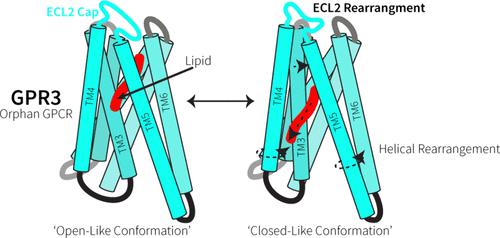当前位置:
X-MOL 学术
›
Biochemistry
›
论文详情
Our official English website, www.x-mol.net, welcomes your feedback! (Note: you will need to create a separate account there.)
Lipid-Dependent Activation of the Orphan G Protein-Coupled Receptor, GPR3
Biochemistry ( IF 2.9 ) Pub Date : 2024-02-20 , DOI: 10.1021/acs.biochem.3c00647 Isabella C. Russell 1, 2 , Xin Zhang 1, 2 , Fabian Bumbak 1, 2 , Samantha M. McNeill 1 , Tracy M. Josephs 1, 2 , Michael G. Leeming 3 , George Christopoulos 1 , Hariprasad Venugopal 4 , Maria M. Flocco 5 , Patrick M. Sexton 1, 2 , Denise Wootten 1, 2 , Matthew J. Belousoff 1, 2
Biochemistry ( IF 2.9 ) Pub Date : 2024-02-20 , DOI: 10.1021/acs.biochem.3c00647 Isabella C. Russell 1, 2 , Xin Zhang 1, 2 , Fabian Bumbak 1, 2 , Samantha M. McNeill 1 , Tracy M. Josephs 1, 2 , Michael G. Leeming 3 , George Christopoulos 1 , Hariprasad Venugopal 4 , Maria M. Flocco 5 , Patrick M. Sexton 1, 2 , Denise Wootten 1, 2 , Matthew J. Belousoff 1, 2
Affiliation

|
The class A orphan G protein-coupled receptor (GPCR), GPR3, has been implicated in a variety of conditions, including Alzheimer’s and premature ovarian failure. GPR3 constitutively couples with Gαs, resulting in the production of cAMP in cells. While tool compounds and several putative endogenous ligands have emerged for the receptor, its endogenous ligand, if it exists, remains a mystery. As novel potential drug targets, the structures of orphan GPCRs have been of increasing interest, revealing distinct modes of activation, including autoactivation, presence of constitutively activating mutations, or via cryptic ligands. Here, we present a cryo-electron microscopy (cryo-EM) structure of the orphan GPCR, GPR3 in complex with DNGαs and Gβ1γ2. The structure revealed clear density for a lipid-like ligand that bound within an extended hydrophobic groove, suggesting that the observed “constitutive activity” was likely due to activation via a lipid that may be ubiquitously present. Analysis of conformational variance within the cryo-EM data set revealed twisting motions of the GPR3 transmembrane helices that appeared coordinated with changes in the lipid-like density. We propose a mechanism for the binding of a lipid to its putative orthosteric binding pocket linked to the GPR3 dynamics.
中文翻译:

孤儿 G 蛋白偶联受体 (GPR3) 的脂质依赖性激活
A 类孤儿 G 蛋白偶联受体 (GPCR) GPR3 与多种疾病有关,包括阿尔茨海默病和卵巢早衰。GPR3 与 Gαs 组成型偶联,导致细胞内产生 cAMP。虽然该受体的工具化合物和几种假定的内源配体已经出现,但其内源配体(如果存在)仍然是个谜。作为新的潜在药物靶标,孤儿 GPCR 的结构越来越受到人们的关注,揭示了不同的激活模式,包括自身激活、组成型激活突变的存在或通过隐秘配体。在这里,我们展示了孤儿 GPCR、GPR3 与 DNGαs 和 Gβ 1 γ 2复合物的冷冻电子显微镜 (cryo-EM) 结构。该结构揭示了结合在延伸的疏水沟内的类脂质配体的清晰密度,这表明观察到的“组成性活性”可能是由于通过可能普遍存在的脂质激活所致。对冷冻电镜数据集中构象变化的分析揭示了 GPR3 跨膜螺旋的扭转运动,这似乎与类脂质密度的变化相协调。我们提出了一种脂质与其假定的与 GPR3 动力学相关的正位结合袋结合的机制。
更新日期:2024-02-20
中文翻译:

孤儿 G 蛋白偶联受体 (GPR3) 的脂质依赖性激活
A 类孤儿 G 蛋白偶联受体 (GPCR) GPR3 与多种疾病有关,包括阿尔茨海默病和卵巢早衰。GPR3 与 Gαs 组成型偶联,导致细胞内产生 cAMP。虽然该受体的工具化合物和几种假定的内源配体已经出现,但其内源配体(如果存在)仍然是个谜。作为新的潜在药物靶标,孤儿 GPCR 的结构越来越受到人们的关注,揭示了不同的激活模式,包括自身激活、组成型激活突变的存在或通过隐秘配体。在这里,我们展示了孤儿 GPCR、GPR3 与 DNGαs 和 Gβ 1 γ 2复合物的冷冻电子显微镜 (cryo-EM) 结构。该结构揭示了结合在延伸的疏水沟内的类脂质配体的清晰密度,这表明观察到的“组成性活性”可能是由于通过可能普遍存在的脂质激活所致。对冷冻电镜数据集中构象变化的分析揭示了 GPR3 跨膜螺旋的扭转运动,这似乎与类脂质密度的变化相协调。我们提出了一种脂质与其假定的与 GPR3 动力学相关的正位结合袋结合的机制。



























 京公网安备 11010802027423号
京公网安备 11010802027423号